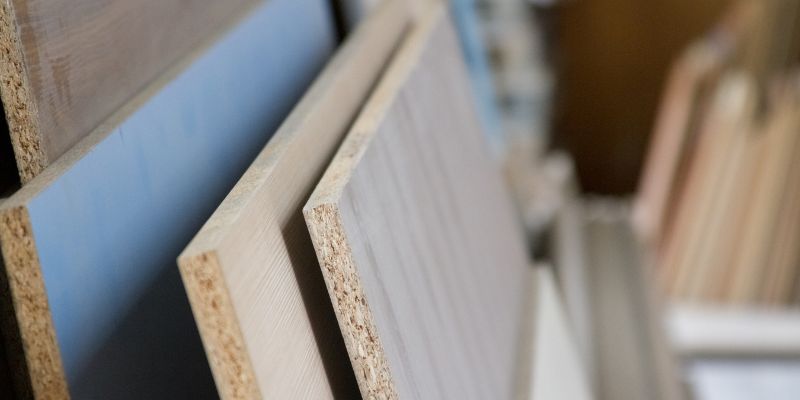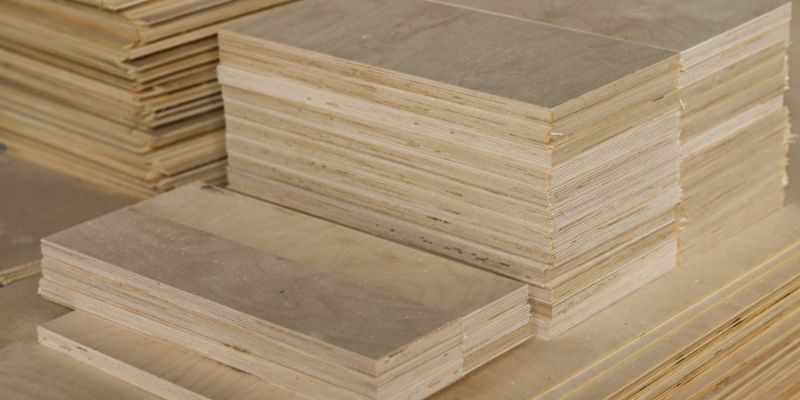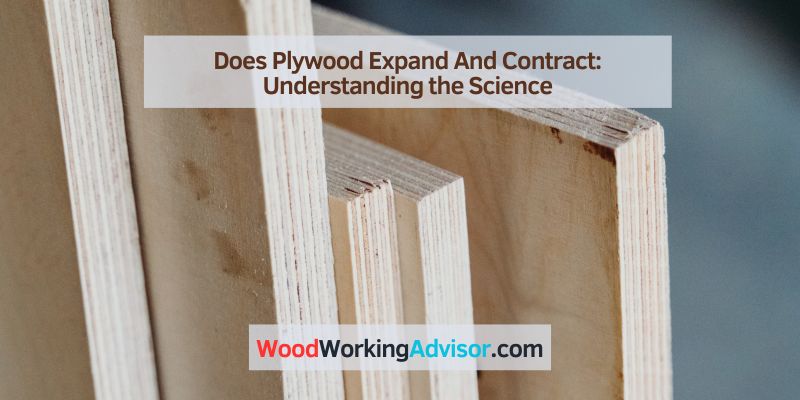Plywood does expand and contract due to changes in humidity and temperature. This movement can cause issues if not properly accounted for in construction projects.
Plywood is a versatile and commonly used material in construction. It’s made by gluing together thin layers of wood, called veneers, with the grains of adjacent layers running in perpendicular directions. This process gives plywood its strength and stability. However, due to the natural properties of wood, plywood is prone to expanding and contracting with changes in environmental conditions.
This movement can lead to warping, twisting, or delamination if not managed properly. Understanding plywood’s tendency to expand and contract is crucial for ensuring the long-term stability and integrity of any construction project.
Plywood Expansion And Contraction: The Basics
Plywood is a widely-used building material known for its strength and versatility. It’s crucial to understand how plywood expands and contracts to ensure its proper installation and longevity. Let’s delve into the basics of plywood expansion and contraction.
Definition Of Plywood Expansion And Contraction
Plywood expansion and contraction refer to the dimensional changes that occur in plywood due to variations in moisture content and temperature. These changes can lead to warping, buckling, or cracking if not properly accounted for during installation.
Factors Affecting Plywood Expansion And Contraction
Moisture Content
Moisture content plays a significant role in plywood expansion and contraction. When exposed to high humidity, plywood absorbs moisture, causing it to swell. Conversely, in dry conditions, the moisture content decreases, leading to shrinkage.
Temperature Variations
Temperature variations can also impact plywood dimensions. Heat can cause expansion, while cold temperatures can lead to contraction. Rapid temperature changes can exacerbate these effects, potentially causing structural issues.
Plywood Grades and Types
The grade and type of plywood can influence its susceptibility to expansion and contraction. Different grades and types have varying levels of resistance to moisture and temperature changes, impacting their dimensional stability.

Understanding Moisture Content In Plywood
Plywood is a versatile building material, but understanding its moisture content is crucial for its long-term performance. The moisture content in plywood directly affects its stability and durability.
Impact Of Moisture On Plywood
Moisture can cause plywood to expand, contract, and warp, which can compromise its structural integrity. Understanding the impact of moisture on plywood is essential for designing and constructing durable, long-lasting projects.
Moisture Measurement In Plywood
Measuring the moisture content in plywood is crucial to ensure its suitability for specific applications. Moisture meters are widely used to determine the moisture levels in plywood and prevent potential issues caused by high or low moisture content.
Equilibrium Moisture Content (emc)
The equilibrium moisture content (EMC) represents the moisture level at which plywood remains stable when exposed to specific humidity and temperature conditions. Understanding the EMC of plywood is vital for preventing dimensional changes due to moisture variations.
Moisture Meters And Their Role
Moisture meters play a crucial role in monitoring and maintaining the appropriate moisture levels in plywood. Using accurate moisture meters helps to ensure that plywood meets the required standards for a particular application, reducing the risk of moisture-related damage.
Effects Of Temperature Variations On Plywood
Relationship Between Plywood And Temperature
Plywood is an engineered wood product composed of layers of wood veneers bonded together with adhesives. Its dimensional stability under varying temperature conditions is critical to its structural integrity and performance.
Thermal Expansion And Contraction In Plywood
Plywood is susceptible to expansion and contraction due to changes in temperature. As the temperature rises, plywood tends to expand, while it contracts as the temperature decreases. This cyclic process of expansion and contraction creates stress within the material, which can lead to warping, twisting, and cracking if not properly managed.
Types And Grades Of Plywood And Their Reaction To Environmental Factors
When it comes to working with plywood, understanding how different types and grades react to environmental factors is crucial for successful project outcomes. Plywood, known for its versatility and strength, is a popular choice in construction and woodworking industries. However, it’s important to note that plywood does expand and contract in response to changes in moisture and temperature. This can directly impact the stability and appearance of the final product.
Influence Of Plywood Grades On Expansion And Contraction
Plywood grades play a significant role in determining the material’s response to environmental changes. Lower-grade plywood, typically used for structural purposes, may be more prone to expansion and contraction due to inconsistencies in the internal layers. Conversely, higher-grade plywood, such as A-grade or marine plywood, is engineered with greater uniformity, reducing the risk of significant dimensional changes. The grade determines the quality of the plywood’s internal layers, which directly impacts its stability.
Comparative Analysis Of Plywood Types
Different types of plywood also exhibit varying degrees of expansion and contraction. For instance, softwood plywood is known to be more susceptible to dimensional changes compared to hardwood plywood due to the inherent traits of the wood species used. Additionally, veneer core plywood and particleboard core plywood may respond differently to environmental factors, with veneer core plywood generally offering better stability. Understanding the characteristics of each type is essential for selecting the most suitable option for a specific application.

Methods To Minimize Plywood Expansion And Contraction
The natural characteristics of plywood make it susceptible to expansion and contraction due to environmental factors such as temperature and humidity. To minimize these effects and ensure the longevity of plywood projects, it is crucial to employ proper techniques and precautions during installation and usage. Here are some effective methods to minimize plywood expansion and contraction:
Proper Installation And Acclimatization Techniques
Proper installation of plywood is essential to minimize the risk of expansion and contraction. Ensure that the plywood is evenly spaced and securely fastened to allow for natural movement. Acclimatization of the plywood to the environment in which it will be used is also crucial. Before installation, the plywood should be allowed to adjust to the temperature and humidity of the room or space to minimize future expansion or contraction.
Varnishing And Sealing For Protection From Environmental Factors
Varnishing and sealing the plywood surface provide a protective barrier against moisture and humidity. A high-quality sealant can prevent water absorption, thereby reducing the risk of expansion. Properly sealed plywood will also be less prone to contracting in dry conditions. Regular maintenance and resealing is essential to uphold the protective properties of the varnish or sealant.
Consideration Of Climate And Seasonal Changes In Plywood Usage
Considering the climate and seasonal changes is crucial when utilizing plywood in various projects. For instance, utilizing marine-grade plywood for outdoor applications can provide better resistance to moisture and minimize expansion and contraction. Adapting plywood usage based on the seasonal changes in temperature and humidity can also help minimize the impact of environmental factors.
Frequently Asked Questions On Does Plywood Expand And Contract
How Much Will A Plywood Panel Expand And Contract?
Plywood panels can expand and contract based on temperature and humidity. The amount varies depending on the type and quality of the plywood. Proper installation and acclimatization are key to minimizing these changes.
Do You Have To Worry About Expansion And Contraction With Plywood?
Plywood does expand and contract, but proper installation and climate control can minimize its impact. Using the correct type of plywood for the specific application also helps to reduce the effects of expansion and contraction. Regular maintenance and sealing can further prevent any issues.
How Much Can Plywood Expand?
Plywood can expand by about 1/8 inch for every 4 feet due to changes in humidity and moisture.
What Is The Expansion Rate Of Plywood?
The expansion rate of plywood is generally around 1/8 inch per 4 feet of panel width. This can vary depending on factors like temperature and humidity.
Conclusion
To sum up, plywood does indeed expand and contract due to changes in moisture levels. Understanding these characteristics is crucial for using it in various applications. By incorporating proper installation and maintenance methods, you can minimize the potential negative effects of plywood expansion and contraction.
Stay informed and take the necessary preventive measures to ensure the longevity of your plywood projects.



One thought on “Does Plywood Expand And Contract: Understanding the Science”